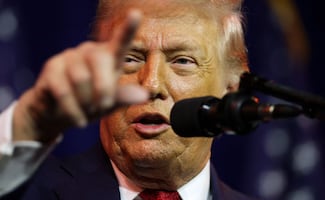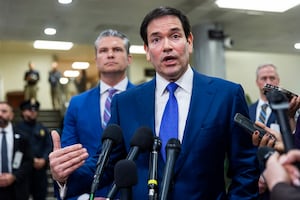Más Información

VIDEO: EU intercepta otro petrolero sancionado, ahora en el Caribe; suman dos buques incautados este miércoles

VIDEO: Desarticulan en Europa red de tráfico de metanfetamina ligada al Cártel de Sinaloa; era introducida en mármol importado de México

Trump recibirá a petroleras el viernes para hablar de Venezuela; EU pide acceso total a explotación de petróleo

Sheinbaum aborda con cónsules y embajadores situación en Venezuela y EU; revisan planes para 2026 y “momento histórico”

Josefa González-Blanco, la embajadora que da paso a Gertz Manero en Reino Unido; estas son sus polémicas
So the checks and balances have been restored in Washington after the United States’ midterm elections .
Democrats
won the majority in the House of Representatives and although the Republicans expanded their majority in the Senate , the White House will have to negotiate in several issues or face the risk of gridlock during the next two years.
How will the outcome of the midterms affect Mexico ? For starters, it is likely that the worst excesses of President Donald Trump regarding immigration —from the deployment of 7,000 troops in the border to the pressure to turn Mexico into a “safe third country” for Central American asylum seekers,—would be moderated by a Democratic lower house of Congress more inclined to regularize the status of the Dreamers , now in the middle of a legal battle.
On the other hand, the changes on the U.S. political map toward the 2020 Presidential election announces new problems for trade liberalization and potentially for the renegotiated North American Free Trade Agreement ( NAFTA ), formally known as the United States-Mexico-Canada Agreement ( USMCA ), still awaiting approval in Capitol Hill.
Contrary to pre-election polls, the Democrats made their main progress in the Midwest , the region surprisingly won by Trump in 2016 exploiting the middle-class frustration and fears due to the high level of unemployment and the fall of living standards .
It was in the Midwest states, the deindustrialized region also known as the Rust Belt , where NAFTA and global free trade were used as a scapegoat for the loss of competitiveness and the unfavorable economic trends.
In this election cycle, both parties played the protectionism card in the Midwest, to the extent that some media outlets are alluding to Senator Sherrod Brow n ( D-Ohio ), who won re-election despite the state trending Republican in the last years, as a possible vice presidential pick in 2020 thanks to his support of Trump’s tariffs on Mexican and Canadian steel imports .
On Wednesday, Trump stressed his plans to “get back to work and get things done”, particularly on trade deals .
Before the new 116th Congress is sworn in on January 3, 2019 , lawmakers must pass legislation to fund the federal government and will likely be asked to ratify USMCA in the lame-duck session that will begin next week, a goal that would be less certain with a Democratic-controlled House .
In the long term, however, the USMCA’s “ sunset clause ” promoted by the Trump administration itself could contain the seeds of uncertainty for the trilateral deal.
Protectionist Congress
The sunset provision states that the agreement shall terminate 16 years after it enters into force unless certain conditions are met, and it could be used by a protectionist U.S. Congress to justify its intervention, since the provision references “the parties” as being responsible for deciding whether or not USMCA will continue and to make recommendations to its Free Trade Commission for a joint review, yet does not make clear who within each country’s government has the ultimate power to terminate the agreement.
Without a clearly defined role for Congress, the clause may put the fate of USMCA entirely in the hands of the executive branch, yet the U.S. Constitution gives power over trade to the legislative branch, an option that future lawmakers would be eager to reclaim.
According to the Mexican government, the USMCA would be signed on November 30 within the framework of the G20 summit in Buenos Aires , Argentina .
The incoming administration of President-elected Andrés Manuel López Obrador has said that the Mexican Senate and the 32 state legislatures will ratify the deal—it would enter into force on 2020—, while the Canadian Parliament plans to review it on January.
For the moment, other voices are proposing to take advantage of the new provisions included in the USMCA, which elevates side agreements to full treaty status.
For instance, to create a “N orth American common front on critical minerals ,” the U.S. should conclude side agreements to encourage cross-border collaboration on critical mineral production and advanced materials processing to ensure that the rich geologic assets of North America are fully leveraged for the benefit of the continent’s surety of supply, highlighted Daniel McGroarty , former White House special assistant at the U.S. Department of Defense .
“While Canada ’s status as a resource producer is beyond question, Mexico is among the United States’ leading providers of four minerals and metals on the U.S. Critical Minerals List for which the U.S. is between 75 and 100% import-dependent,” wrote McGroarty in The Hill website.
Washington should drop the so-called Section 232 tariffs—named for the seldom-used section of the 1962 Trade Expansion Act —on steel and aluminum imports from Canada and Mexico, he added, so that “the U.S. defense supply chain is once again fully integrated across North America.”
It is worth to mention that the persistence of these tariffs is tarnishing the start of the USMCA, at least from the Canadian point of view.
Ottawa’s ambassador in Washington
, David MacNaughton , told CBC News that Prime Minister Justin Trudeau will not be taking part in any sort of signing ceremony alongside Trump—not unless the tariffs are lifted first.
“I can’t imagine some kind of a celebratory event as long as those tariffs are in place. We will conduct our business and sign on what we agreed to, but we’ll hold the celebration until we get rid of those tariffs,” he remarked.
Editing by Sofía Danis
More by Gabriel Moyssen
Noticias según tus intereses
[Publicidad]
[Publicidad]










